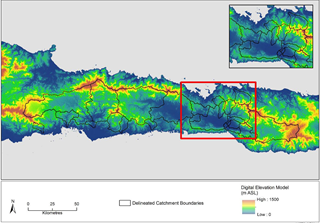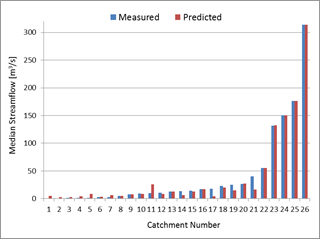 The study region covers a number of catchments – delineated in black – in the mountainous terrain of the Minahassa peninsula.
The study region covers a number of catchments – delineated in black – in the mountainous terrain of the Minahassa peninsula. Connecting remote areas - for instance in the mountains of northern Sulawesi - to the power grid is an expensive task. Therefore, local hydropower production from small power plants – so called mini-hydropower plants – can be a viable alternative. DHI investigated the hydrological characteristics of the Minahassa Peninsula region and specifically the river Sungai Bone in Gorontalo province, Indonesia, in order to evaluate its mini-hydropower potential. Similar projects in the region are currently underway.
The common way to assess the hydropower potential of a stream is its flow duration curve (FDC), which depicts the probability of a certain discharge. The FDC contains information on the expected base flow as well as the maximum flows – and therewith on necessary safety and protection measures against e.g. flash floods.
 A comparison of measured and predicted values of streamflow for various catchments showcases the accuracy of the derived relationship.
A comparison of measured and predicted values of streamflow for various catchments showcases the accuracy of the derived relationship. However, especially in remote regions data on streamflow are often scarce, making the development of a FDC very challenging. Therefore, we collected and processed a large set of auxiliary data, (such as catchment size, remotely sensed rainfall data, soil types, topography derivatives, etc), using available streamflow data from nearby rivers to explore correlations between catchment/meterological parameters and each river’s streamflow data. Intense research revealed a strong predictive relationship for the region, especially significant with parameters relating to orographic rainfall (rainfall caused by the lifting of moist air over a topographic barrier, such as a mountain range). This derived relationship was then used to develop the FDC of Sungai Bone.
With this information at hand, our client is now able to start the approval process and apply for the necessary permits to start mini-hydropower production in Sungei Bone, potentially producing up to 7.5 MW of power in the proposed low head hydropower facility.